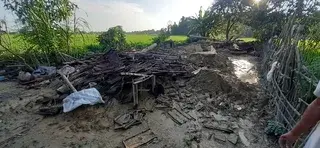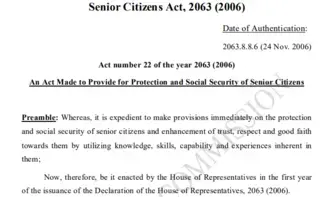BAITADI — Whenever parents take a cheena (a birth chart made as per the Hindu astrological calendar) of their children to Dev Dutta Bhatta, at first glance the astrologer-cum-priest makes sure he has his eyes on the birth year. “Any oversight on my part can destroy the lives of adolescent girls,” says the 66-year-old from far-western Nepal dressed in the traditional clothes – a cream kurta suruwal (a collarless shirt and trousers) and a black peaked Nepali cap and singing Hindu hymns.
Recently, a couple from the same district, Baitadi, approached Bhatta to know the lucky months for their 16-year-old daughter and whether the tenth Grader had to begin a fasting to appease the Hindu Gods. Before anything he asked them back, “Are you thinking of marrying off your daughter?” “Well, we might if a proposal comes from a well-established boy” came the retort from the couple. He told them straight out he could only say that if they brought her cheena, determined to convince them that waiting till she would turn 20 was the way to go.
“Some parents, mostly those who have daughters, have plans to marry off their children at an early age. When they come to us they lie about the age of their young girls. The birth date mentioned in the cheena is always true and alerts us to the possibility of child marriages taking place and the need to stop this from happening.”
Scary scenario
Adolescent girls (10-19 years) are a significant portion of Nepal’s population. There are more than six million teenagers, - about one fourth of the country’s total population - and half of these are girls. Around 24.5 percent of girls aged 15-19 are currently married or in union and 16 percent of women aged 20-24 years have already had at least one live birth before reaching 18.
Around 35 percent of women aged 10-24 are dropping out of school, college or university. The adolescent birth rate is 71 births per 1,000 women aged 15-19 years—one of the highest in South Asia. It is widely believed that early marriages are common in Far-Western Nepal, a geographically remote region where awareness about the legal age and consequences of child marriage is limited and the practice of early marriage generally accepted as part of social norms and values.
Faith-based leaders leading the way
So far Bhatta has rescued six prospective adolescent brides by stopping their marriages. A priest from neighbouring district Dadeldhura, Bhojraj Chataut (61), has also stopped five child marriages. In nearby Chataut’s village, his friend Tara Datta Panta convinced a couple to cancel the marriage of a local girl, having discovered from her birth chart that she was not even 18.
Though in a different profession, Padam Singh Mahara (68) has convinced two couples to postpone the marriage of their daughters until at least the age of 20 — the minimum marriageable age allowed by law in Nepal for both girls and boys.

“Some people think we are quite conservative with traditional beliefs that are against development. But this is not true. The work we are doing against child marriage is because we have a bigger role to play in the transformation of the society that we are part of,” says Mahara, a popular local Hindu shaman and one who has been practicing shamanism over the last 42 years.
Shyam Bahadur Bhandari (55) has also stopped two child marriages. Both of them claim that they have “special powers” to control the evil spirits and heal people from illnesses, bad luck etc. “We not only help people get rid of evil spirits and sickness, but also fight against social evils like child marriage,” says Bhandari.
These faith-based leaders have played a vital role in raising awareness in their communities and schools on their own based on an action plan they had developed after discussing what could be done to stop child marriage, having gained a deeper understanding of its negative consequences. Bhojraj Joshi, a priest, organizes village level awareness programmes and school orientation sessions. Bhatta does a similar work. “I’ve already organized six and gearing up for more. Earlier, I only used to tell villagers their fortune. Now I also tell them it is illegal to marry off their children before they reach 20 as many girls suffer because of child marriage.”
An innovative collaboration for a cause
In many parts of Far-Western Nepal and also in other areas of the Hindu dominated country, priests, astrologers and shamans hold sway over people's opinions and ideas. Given their influence at community level and seeing the role they can play as a gatekeeper and change-maker, UNFPA works hand in hand with the District Women and Children Offices in the Far Western Region to collaborate with faith-based leaders to end harmful practices, including child marriage.
In order to support priests, astrologers and traditional healers to become active enablers in their communities, the Women and Children’s Offices and UNFPA in districts like Baitadi and Dadeldhura raised their awareness on their role in ending child marriage, the continuum of harms, causes and legal provisions and supported them to draft an action plan. The four-point action plan includes what activities the trained priests, traditional healers and astrologers will carry out in their villages to prevent child marriage as well as how and by when they will achieve the desired results. In some villages of Dadeldhura, follow-up training sessions are being organized at the community level.
“The collaboration among the Women and Children Office, UNFPA, pandit-jyotishi-dhami (priests, astrologers and shamans) and networks of adolescent girls is slowly making strides in ending child marriage and gender-based violence,” says Manmati Tailor (18), the chairperson of the Adolescent Girls’ Circle in the Hatairaj village of Baitadi. “Influential leaders are having an impact, one less child marriage at the time.”




